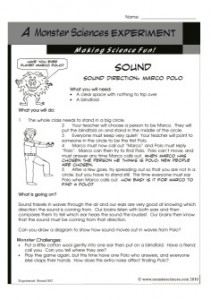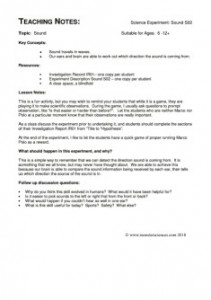Play a modified version of Marco Polo to learn about sound directionality.
 |
 |
What you will need:
- A clear space with nothing to trip over
- A blindfold
What you will do:
- The whole class needs to stand in a big circle.
- Your teacher will choose a person to be Marco. They will put the blindfold on and stand in the middle of the circle.
- Everyone must keep very quiet! Your teacher will point to someone in the circle to be the first Polo.
- Marco must now call out “Marco” and Polo must reply “Polo”. Marco can then try to find Polo. Polo can’t move, and must answer any time Marco calls out. When Marco has chosen the person he thinks is Polo, new people are chosen.
- After a few goes, try spreading out so that you are not in a circle, but you have to stand still. This time everyone must say Polo when Marco calls out. How easy is it for Marco to find a Polo?
What is going on?
Sound travels in waves through the air and our ears are very good at knowing which direction the sound is coming from. Our brains listen with both ears and then compares them to tell which ear hears the sound the loudest. Our brains then know that the sound must be coming from that direction.
Can you draw a diagram to show how sound moves out in waves from Polo?
Monster Challenges:
- Put a little cotton wool gently into one ear then put on a blindfold. Have a friend call you. Can you tell where they are?
- Play the game again, but this time have one Polo who answers, and everyone else claps their hands. How does this extra noise affect finding Polo?
Teaching Notes:
Topic:
Sound
Key Concepts:
¨ Sound travels in waves.
¨ Our ears and brain are able to work out which direction the sound is coming from.
Resources:
- Investigation Record IR01– one copy per student
- Experiment Description Sound S02 – one copy per student
- A clear space, a blindfold
Lesson Notes:
This is a fun activity, but you may wish to remind your students that while it is a game, they are playing it to make scientific observations. During the game, I usually ask questions to prompt observation, like “is that easier or harder than before?”. Let the students who are neither Marco nor Polo at a particular moment know that their observations are really important.
As a class discuss the experiment prior to undertaking it, and students should complete the sections of their Investigation Report IR01 from ”Title to “Hypothesis”.
At the end of the experiment, I like to let the students have a quick game of proper running Marco Polo as a reward.
What should happen in this experiment, and why?
This is a simple way to remember that we can detect the direction sound is coming from. It is something that we all know, but may never have thought about. We are able to achieve this because our brain is able to compare the sound information being received by each ear, then tells us which direction the source of the sound is in.
Follow up discussion questions:
- Why do you think this skill evolved in humans? What would it have been helpful for?
- Is it easier to pick sounds to the left or right that from the front or back?
- What would happen if you couldn’t hear as well in one ear?
- What is this skill useful for today? Sports? Safety? What else?
Get this experiment here or as part of a bundle of Sound Experiments here.



